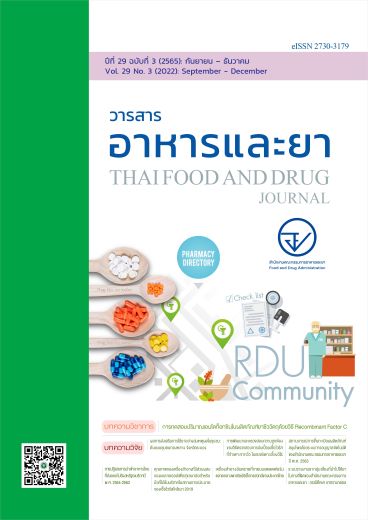ผลการส่งเสริมการใช้ยาอย่างสมเหตุผลในชุมชน: ต้นแบบชุมชนทองหลาง จังหวัดระนอง
Main Article Content
บทคัดย่อ
ความสำคัญ : การใช้ยาอย่างสมเหตุผลคือการให้ผู้ป่วยได้รับยาอย่างเหมาะสมตามความจำเป็นในการรักษาอาการเจ็บป่วยที่เกิดขึ้น ทั้งขนาดยา และระยะเวลาที่เหมาะสม แต่ทั่วโลกพบการเสียชีวิตจากการใช้ยาไม่สมเหตุผลจำนวนมาก สำหรับประเทศไทยยังมีการใช้ยาโดยไม่มีข้อบ่งใช้ทางการแพทย์ ใช้ยาเกินความจำเป็น ส่งผลให้เกิดการเจ็บป่วย และเสียชีวิต ซึ่งการศึกษานี้เป็นการส่งเสริมประชาชนในชุมชนและศึกษาการใช้ยาอย่างสมเหตุผลในพื้นที่จังหวัดระนอง
วัตถุประสงค์: เพื่อศึกษาผลของกิจกรรมการส่งเสริมการใช้ยาอย่างสมเหตุผลต่อความรู้และพฤติกรรมของประชาชนในชุมชนทองหลาง ตำบลบ้านนา อำเภอกะเปอร์ จังหวัดระนอง
วิธีการวิจัย: เป็นการศึกษาวิจัยปฏิบัติการ (action research) ในพื้นที่หมู่ที่ 3 ตำบลบ้านนา อำเภอกะเปอร์ จังหวัดระนอง โดยใช้ 5 กระบวนการได้แก่ ประชุมภาคีเครือข่ายเพื่อกำหนดมาตรการทางสังคม ลงพื้นที่เยี่ยมบ้านและร้านชำ อบรมรณรงค์ให้ความรู้ รณรงค์ และถอดบทเรียน จากนั้นสำรวจความรู้และพฤติกรรมกลุ่มตัวอย่างอายุ 16 ปีขึ้นไปที่เข้าร่วมกิจกรรมตลอดโครงการด้วยการสุ่มอย่างง่ายและจับฉลากจำนวน 200 ตัวอย่าง ที่ระดับความเชื่อมั่น 95% รวมทั้งลงพื้นที่เยี่ยมบ้านโดยคัดเลือกแบบจำเพาะเจาะจง (purposive sampling) จำนวน 98 ครัวเรือน และสำรวจประชากรร้านชำทั้งหมดในพื้นที่จำนวน 4 แห่ง วิเคราะห์หาความสัมพันธ์ก่อนและหลังดำเนินกิจกรรมโดยใช้ Paired sample t-test กำหนดค่านัยสำคัญที่ p-value 0.05
ผลการวิจัย: ผลการส่งเสริมการใช้ยาอย่างสมเหตุผลในชุมชนพบว่า กลุ่มตัวอย่างประชาชนส่วนใหญ่เป็นเพศหญิง ร้อยละ 52.50 อายุตั้งแต่ 41 ปีขึ้นไป ร้อยละ 71.50 ส่วนใหญ่มีการศึกษาระดับประถมศึกษา ร้อยละ 66.00 ประกอบอาชีพเกษตรกร ร้อยละ 81.50 และมีโรคประจำตัว ร้อยละ 24.50 เมื่อศึกษาความรู้การบริโภคยาอย่างสมเหตุผล พบว่า กลุ่มตัวอย่างมีความรู้เพิ่มขึ้นอย่างมีนัยสำคัญทางสถิติที่ p<0.05 จากระดับปานกลาง 6.12 เป็นระดับสูงสุดคือระดับมาก 8.91 คะแนน จากคะแนนเต็ม 10 คะแนน หัวข้อที่กลุ่มตัวอย่างร้อยละ 96.00 มีความรู้ที่ถูกต้องหลังรณรงค์มากที่สุด ได้แก่ การกินยาที่ใส่สารสเตียรอยด์ว่าเมื่อกินอย่างต่อเนื่องจะทำเกิดอาการข้างเคียงและอาจถึงขั้นเสียชีวิตได้ ความรู้เกี่ยวกับยาชุดที่อวดอ้างสรรพคุณว่าสามารถรักษาได้สารพัดโรคมักผสมสารสเตียรอยด์ และความรู้เกี่ยวกับการใช้ยาปฏิชีวนะอย่างพร่ำเพรื่ออาจได้รับอันตรายจากการแพ้ยาทำให้เกิดภาวะเชื้อดื้อยาได้ ยกเว้นร้อยละ 63.00 ที่มีความรู้ที่ว่ายาปฏิชีวนะไม่สามารถรักษาโรคที่เกิดจากการติดเชื้อไวรัสหรือเชื้อราซึ่งเป็นหัวข้อที่มีคะแนนน้อยที่สุด นอกจากนั้น ยังพบว่ากลุ่มตัวอย่างมีพฤติกรรมการบริโภคยาอย่างสมเหตุผลในระดับดีมากเพิ่มขึ้นอย่างมีนัยสำคัญทางสถิติที่ p<0.05 โดยมีค่าคะแนนเพิ่มจาก 34.61 เป็น 36.56 คะแนน จากคะแนนเต็ม 40 ซึ่งทุกพฤติกรรมหลังดำเนินกิจกรรมในแต่ละข้อพบอยู่ในระดับดีมาก และเมื่อพิจารณาถึงการสำรวจยากลุ่มเสี่ยงใน 98 ครัวเรือน พบยากลุ่มเสี่ยงครั้งแรก ร้อยละ 12.24 ครั้งที่ 2 พบร้อยละ 0.00 ส่วนร้านชำ พบมีการขายยาไม่เป็นไปตามกฎหมายครั้งแรก ร้อยละ 50.00 แต่ไม่พบในครั้งที่ 2
สรุป: ผลการส่งเสริมการใช้ยาอย่างสมเหตุผลในชุมชนโดยใช้ 5 กระบวนการ ส่งผลให้ประชาชนมีความรู้ที่ถูกต้อง และมีพฤติกรรมการบริโภคยาอย่างสมเหตุผลเพิ่มขึ้นอย่างมีนัยสำคัญทางสถิติที่ p-value < 0.05 ไม่พบยากลุ่มเสี่ยงในครัวเรือน และการขายยาที่ไม่เป็นไปตามกฎหมายกำหนดในร้านชำของชุมชน ดังนั้น ควรนำต้นแบบการดำเนินกิจกรรมส่งเสริมการใช้ยาอย่างสมเหตุผลในชุมชนนี้ไปประยุกต์ใช้ และขยายผลในพื้นที่ชุมชนของจังหวัดต่าง ๆ เพื่อส่งเสริมสุขภาพประชาชนให้ดีขึ้นต่อไป รวมทั้งการวิจัยครั้งต่อไปควรคัดเลือกตัวอย่างที่มีปัญหาการใช้ยากลุ่มเสี่ยงเพื่อศึกษาข้อมูลเชิงลึกต่อไป
Article Details

อนุญาตภายใต้เงื่อนไข Creative Commons Attribution 4.0 International License.
เอกสารอ้างอิง
World Health Organization. Promoting rational use of medicines: core components [Internet]. 2002 [cited 2019 Oct 10]. Available from: https://apps.who.int/medicinedocs/pdf/h3011e/h3011e.pdf
Jim O’Neill. Antimicrobial resistance: tackling a crisis for the health and wealth on nations [Internet]. 2014 [cited 2019 Oct 10]. Available from: https://amr-review.org/sites/default/files/AMR%20Review%20Paper%20%20Tackling%20a%20crisis%20for%20the%20health%20and%20wealth%20of%20nations_1.pdf
ภานุมาศ ภูมาศ, วิษณุ ธรรมลิขิตกุล, ภูษิต ประคองสาย, ตวงรัตน์ โพธะ, อาทร ริ้วไพบูลย์, สุพล ลิมวัฒนานนท์. ผลกระทบด้านสุขภาพ และเศรษฐศาสตร์จากการติดเชื้อดื้อยาต้านจุลชีพในประเทศไทย : การศึกษาเบื้องต้น. วารสารวิจัยระบบสาธารณสุข 2555;6(3):352-60.
รัชตะ รัชตะนาวิน, และคณะ.การศึกษาความชุกของปัญหาทางคลินิกที่เกิดจากการใช้สารที่มีสเตียรอยด์ปะปนโดยไม่มีข้อบ่งชี้ทางการแพทย์ [รายงานวิจัย]. กรุงเทพฯ: สำนักงานกองทุนสนับสนุนการวิจัย.2550
เพชรรัตน์ พงษ์เจริญสุข, กฤติยา ชื่นงูเหลือม, อัมรินทร์ ทักขิญเสถียร, รัชตะ รัชตะนาวิน. การศึกษาต้นทุนทางตรงจากการใช้ยาสเตียรอยด์โดยไม่มีข้อบ่งชี้ทางการแพทย์ในประเทศไทย. วารสารเภสัชกรรมโรงพยาบาล 2550;17:34-41.
คณะอนุกรรมการส่งเสริมการใช้ยาอย่างสมเหตุผล. คู่มือการดำเนินงานโครงการโรงพยาบาลส่งเสริมการใช้ยาอย่างสมเหตุผล (Rational drug use hospital manual) กรุงเทพฯ: ชุมชนสหกรณ์การเกษตรแห่งประเทศไทย; 2558.
คณะกรรมการพัฒนาระบบยาแห่งชาติ. นโยบายแห่งชาติด้านยาและยุทธศาสตร์การพัฒนาระบบยาแห่งชาติ พ.ศ. 2560-2564 [อินเทอร์เน็ต]. นนทบุรี; 2560 [เข้าถึงเมื่อ 10 พ.ย. 2562]. เข้าถึงได้จาก: http://ndi.fda.moph.go.th/uploads/policy_file//20170801145933.pdf
สำนักงานคณะกรรมการอาหารและยา. รายละเอียดตัวชี้วัด เป้าหมาย และแนวทางการดำเนินงานคุ้มครองผู้บริโภคด้านผลิตภัณฑ์สุขภาพในส่วนภูมิภาคประจำปีงบประมาณ พ.ศ. 2564. นนทบุรี: สำนักงานฯ; 2564.
กระทรวงสาธารณสุข. คลังข้อมูลและสารสนเทศด้านสาธารณสุข Health Data Center กระทรวงสาธารณสุข 2021: ประชากรทะเบียนราษฎร์ จำแนกรายอายุและเพศ [อินเทอร์เน็ต].ประเทศไทย: 2561 [เข้าถึงเมื่อ 10 พ.ย. 2561]. เข้าถึงได้จาก: https://rng.hdc.moph.go.th/hdc/reports/report.php?source=pop/pop_sex_agemoph.php&cat_id=ac4eed1bddb23d6130746d62d2538fd0&id=f83d0cd8b830706dab4cd3cb09afa584
Yamane T. Statistics: an Introductory analysis. 3td ed. Newyork: Harper and Row; 1973.
ผุสดี เวชชพิพัฒน์, ภัคพธู อุ่นงามพันธุ์, สุภาภรณ์ ปั้นผล, กรัณฑรัตน์ บุญช่วยธนาสิทธิ์, จินตนา เทียมทิพร. รายงานการสำรวจความรู้และพฤติกรรมการบริโภคผลิตภัณฑ์สุขภาพของประชาชนในชุมชนกลุ่มเป้าหมายของโครงการฯ ที่ 25 จังหวัดดำเนินการภายใต้โครงการเครือข่ายชุมชนร่วมใจ ป้องกันภัยผลิตภัณฑ์สุขภาพ ปีงบประมาณ พ.ศ. 2562 ฉบับสมบูรณ์. นนทบุรี: กองพัฒนาศักยภาพผู้บริโภค สำนักงานคณะกรรมการอาหารและยา; 2562.
Cronbach LJ. Essentials of psychological testing (5th ed.). New York: Harper Collins; 1990.
Bloom BS. Learning for mastery. UCLA – CSEIP - Evaluation comment; 1968:1(2): 47-62.
Best JW. Research in education 3rd ed. Englewood Cilifts, New Jersy: Printice-Hall. 1977.
สิริลักษณ์ รื่นรวย. การจัดการปัญหายาและผลิตภัณฑ์สุขภาพภาพในชุมชน โดยเครือข่าย บวร.ร. วารสารเภสัชกรรมไทย 2563;12:855-68.
รุจิรา ปัญญา. ผลของการจัดการปัญหาการใช้ผลิตภัณฑ์สุขภาพปลอมปนสเตียรอยด์ในชุมชน ในเขตโรงพยาบาลส่งเสริมสุขภาพตำบลขุนลาน อำเภอดอกคำใต้ จังหวัดพะเยา. วารสารเภสัชกรรมไทย 2562;11(3):552-63.


